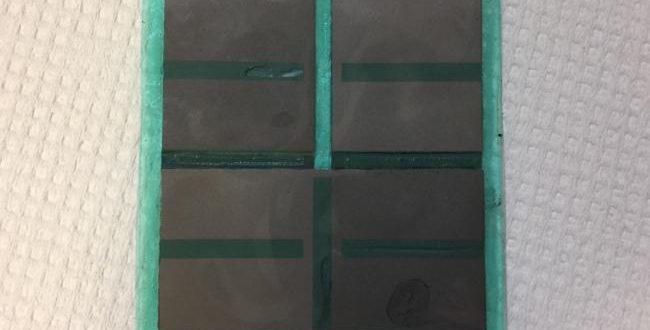Solar panels could soon be made with their own embedded battery storage in what is an Australian global first.
Batteries would be laminated to the back of the panels and deliver “in-built” storage, making it eventually standard for them to deliver energy day or night as required.
It’s one of several plans for ultra-thin, flexible screen-printed batteries that could eventuate within three years and offer new opportunities for manufacturing.
Currently companies such as Tesla and South Australia’s Redflow offer solar panel and battery solutions, but the batteries are separate entities. If this idea takes hold, printed-on storage could be part of an ordinary solar panel.
Because they can be printed in any shape, printed batteries could also power electronic skin treatment patches and other wearable technology.
The project is being undertaken by Printed Energy Pty Ltd, an investee company within the St Baker Energy Innovation Fund, in collaboration with two of Australia’s leading universities in the field of energy storage and materials science, the University of Queensland and the University of New South Wales.
Printed Energy is the principal financial backer. It is providing $1.5 million in direct funding for the project, and $6 million in-kind assistance.
Trevor St Baker, founder of ERM Power and the St Baker Energy Innovation Fund, said printed batteries could transform everyday life.
“Unlike traditional batteries, the printed battery can be any shape required for the specific application, such as wearable electronics and medical and healthcare products such as skin treatment patches,” he said.
“It’s literally the printing of solid state batteries in a thin, flexible format that can be adapted to almost any shape.”
He said printed batteries would transform solar generation from day time energy generation to night time energy delivery.
The $12 million project has also received another shot in the arm: a $2 million grant from the Australian Government’s Cooperative Research Centres Projects scheme.
University of NSW Dean Mark Hoffman hailed the breakthrough as delivering the missing piece of the puzzle for renewable energy.
“The world is crying out for storage solutions, and this partnership has the potential to deliver on that urgent need. What’s exciting is that this technology also has immediate applications in wearables and small-scale devices.”
Chris Greig, director of The University of Queensland Dow Centre for Sustainable Engineering Innovation and the UQ Energy Initiative is enthused about how the technology could transform Australian manufacturing.
“This technology represents not just an opportunity for us to be involved in cutting-edge science and innovation, but presents a real opportunity for the next generation of Australian manufacturing.
“Our mission is to foster and facilitate advances in science and engineering which are technologically, economically and socially sustainable. This project fits the bill perfectly and the range of applications is probably only limited by our imaginations,” he said.
The University of Queensland’s Dow Centre is co-ordinating the research effort.
Established in 2013, Mr St Baker’s fund has invested more than $40 million in the development of such projects.
The first applications of the technology would be in small-scale devices, with development work in large-scale uses over three years. Development would rely on Printed Energy’s proprietary designs.
Chief scientist Alan Finkel’s review of the national electricity market made 50 recommendations for the upgrade of Australia’s electricity grid.
In its statement the University of NSW said the network was essentially a giant complex machine of interlinked control centres, computers and 40,000 km of cabling.
“Focused on improving the reliability and security of the grid, the Finkel report notes the rapid investment in storage at grid-scale, including batteries and pumped hydro, in response to high levels of variable renewable electricity.”
Reader comments on this site are moderated before publication to promote lively and civil debate. We encourage your comments but submitting one does not guarantee publication. We publish hundreds of comments daily, and if a comment is rejected it is likely because it does not meet with our comment guidelines, which you can read here. No correspondence will be entered into if a comment is declined.





